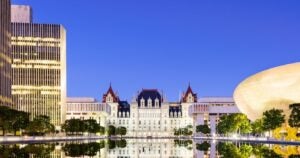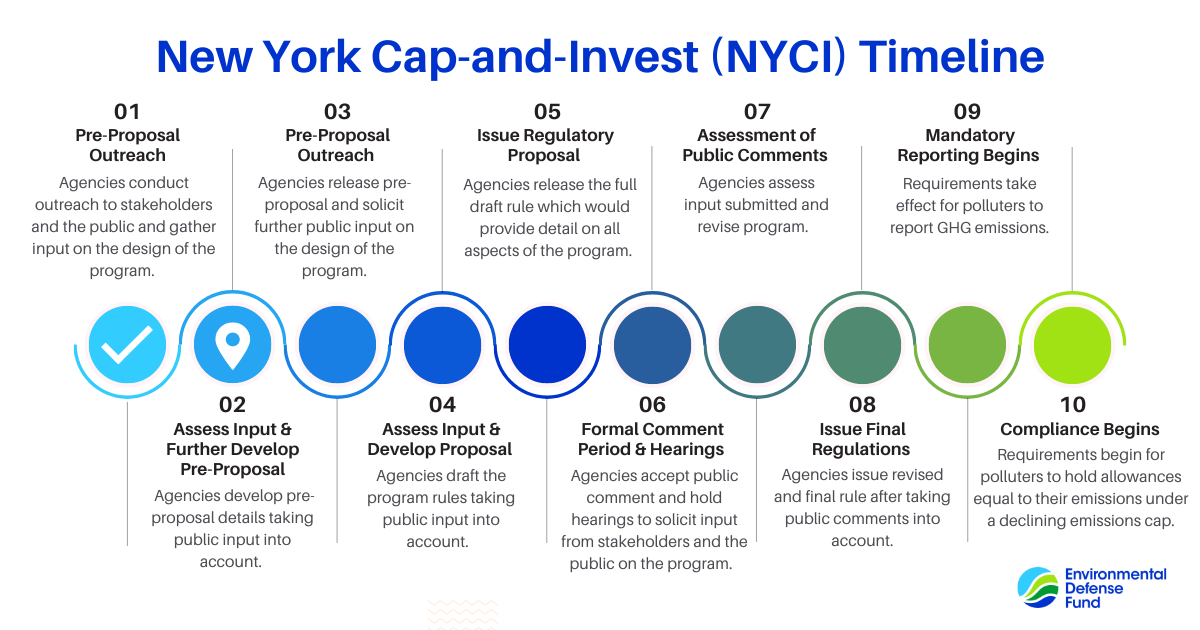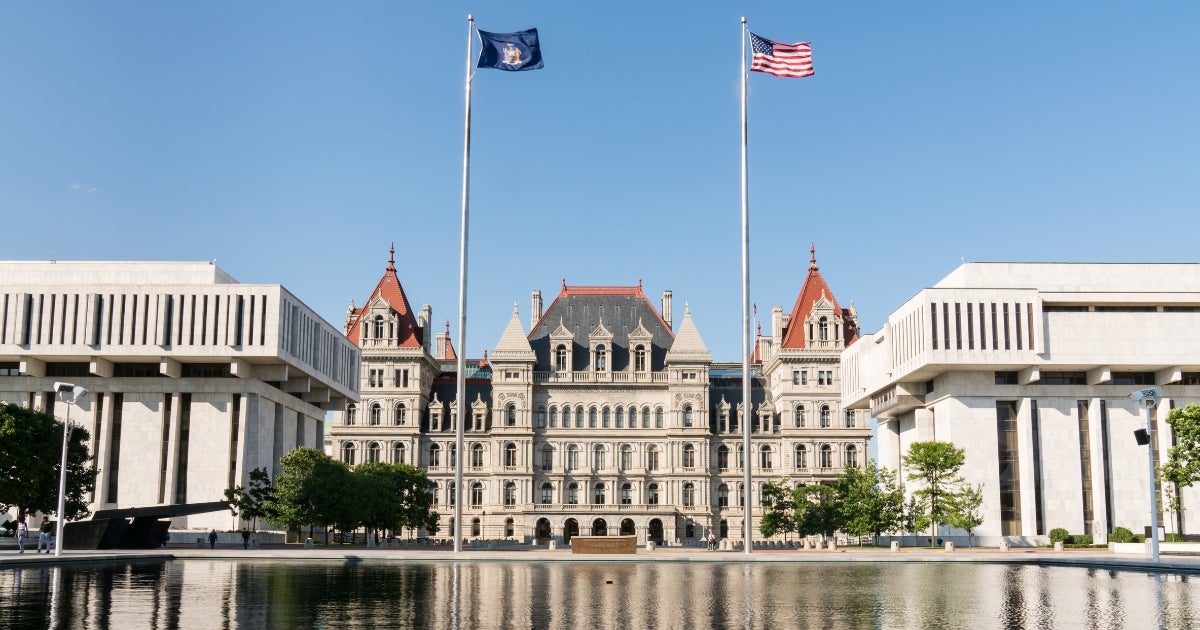
New York is developing a cap-and-invest program to cut climate pollution. How would it work?
As a major next step in achieving New York’s climate targets, Governor Hochul and state agency officials are developing rules for a cap-and-invest program. A bold and equitable program would aggressively cut climate pollution, while supporting and investing in clean and healthy communities around the state.
This rulemaking could be game-changing for New York — and for the nation.
New York would be the third state in the country to put a declining cap — or limit — on emissions across its economy, building on successful models from California and Washington state. And critically, this program is coming together right as new analysis underscores the need for leading states to follow through on their climate commitments and drive national climate progress.
Here’s what to know about how a cap-and-invest program would work in New York as these rules come together.
Cap-and-invest 101
The cap: In a cap-and-invest program, the cap (also referred to as a “limit”) sets the maximum amount of climate pollution that can be emitted in New York each year. New York’s Department of Environmental Conservation will determine the appropriate cap on overall emissions and ensure that it declines each year on track to New York’s climate targets: a 40% reduction in greenhouse gas emissions from 1990 levels by 2030, and at least 85% by 2050.
The cap puts New York’s emissions on a declining trajectory, and working together with other policies, helps maximize certainty that the state will reach its targets. It acts as a firm emissions backstop, ensuring the state makes persistent climate progress without veering off track and minimizing the total amount of heat-trapping climate pollution released year over year (known as cumulative pollution).
Pollution gets a price tag: Pollution has a cost. Greenhouse gases, like carbon dioxide and methane, cause climate damages like more frequent and severe flooding and storms that cost New Yorkers. A cap-and-invest program recognizes this reality and puts a price on pollution. Major polluters under New York’s cap will pay for their emissions through the purchase of emissions “allowances”, which in aggregate add up to the total cap.
If New York structures its program similar to those in other states, polluters covered by the cap would be required to buy and surrender allowances equal to their total emissions at regular intervals. This sends an economic signal to cut pollution. Under many programs, allowances can also be traded or banked for future compliance, subject to certain limits – creating an incentive for earlier, deeper pollution cuts.
As the cap lowers over time, so would the number of available emissions allowances, making pollution more expensive and by contrast making it clearer and clearer: reducing pollution is better for business.
Invest: Revenue raised from the sale of emissions allowances would then be invested back into New York communities to accelerate an equitable clean energy transition, reduce air pollution, protect communities from natural disasters, ensure affordable energy, among other benefits.
Notably, New York’s climate law requires that at least 35% — with a goal of 40% — of the benefits of these investments be directed to disadvantaged communities (DACs). Investments in DACs and around New York state would help to speed New York’s clean energy transition and deliver the health and economic benefits that come with it.
Washington and California are using billions in revenue from their programs to invest in clean transportation, such as zero-emissions buses; resilience to natural disasters; energy efficiency in homes; and much, much more. Similar to New York’s requirements, these programs are prioritizing investments in underserved communities. For example, California agencies report directing 75% of the investments from its program – totaling over $7 billion to date – in low-income communities and communities overburdened by pollution. New York communities have the opportunity to direct and shape investments from its cap-and-invest program in ways that best benefit them.
Furthermore, one-third of revenue in New York’s program must be returned to households and small businesses via rebates or other cost containment mechanisms to keep energy costs affordable for New Yorkers.

How can this program support disadvantaged communities?
New York’s climate law, the Climate Leadership and Community Protection Act (CLCPA), has requirements that prevent harmful air pollutants from increasing in disadvantaged communities that unjustly bear the greatest pollution burdens. Alongside cuts in climate pollution and investments in disadvantaged communities, New York’s cap-and-invest program should put in place guardrails that protect these communities from local air pollution. The rules could, for example, limit pollution for specific facilities that contribute to cumulative pollution burdens. And, the program would work alongside other laws in place in NY focused on monitoring and reducing health-harming air, water, and other pollutants.
Shaped by input from disadvantaged communities, the revenues from the program could be used to fund projects that improve local air quality and public health, create jobs, improve public transit, among other benefits. For example, California’s program has funded over 1,000 projects to expand public transit and over 11,000 affordable housing units. And while Washington’s program is still wrapping up its first year of auctions, the state has raised substantial revenue to be invested in making the clean energy transition more affordable and slashing pollution in vulnerable communities.
How can this program cut climate pollution at the lowest cost?
It’s worth underscoring that the path we’re currently on — continued reliance on polluting fossil fuels leading to worsening climate and health impacts — is an expensive one. Catastrophic flooding, storms, extreme heat, asthma, and other diseases exacerbated by pollution, are costing New Yorkers today and will cost New Yorkers even more tomorrow and in the years to come if we don’t adjust course. In fact, New York’s Climate Plan finds that the cost of inaction on climate change exceeds the cost of achieving New York’s 2030 and 2050 climate targets by at least $115 billion.
A well-designed cap-and-invest program not only provides the greatest certainty of cutting pollution and transitioning New York’s economy to one powered by clean energy, it also offers a cost-effective path to doing so. By putting a price on pollution and allowing businesses some flexibility in how to cut their emissions to comply with the program – while limiting total pollution – these programs incentivize deeper, earlier pollution cuts at lowest cost. Businesses that switch to cleaner technologies, cut their energy use, and innovate to reduce pollution faster become more competitive. And, because businesses under the cap know how the total number of allowances – and overall pollution – will decrease year by year, they can effectively plan and shift to cleaner technologies and practices over time.
In short, a price on pollution ensures no opportunity is missed to cut pollution cost-effectively. From the Regional Greenhouse Gas Initiative targeting power sector emissions in the northeast, to statewide programs in California and Washington, and others around the world, these types of systems have helped to slash climate pollution cost-effectively while driving significant investments in communities and furthering climate action.
What’s more, as New York leaders design their program with input from the public, they have an opportunity to ensure costs are not borne by New Yorkers who can least afford them:
- Putting money back in the pockets of New Yorkers: The Hochul administration and New York legislators have already prioritized affordability in developing the rules and committed to directly returning one-third of the raised revenue to households and small businesses. This mechanism should be designed to protect middle- and low-income households first and foremost, which spend more of their budget on energy costs.
- Linking carbon markets: Linking to other carbon markets, like the joint California-Quebec market, provides more opportunities for businesses to find lower-cost options to reduce their emissions, which can drive up climate ambition, while driving down costs. That is why Washington recently decided to pursue linkage, and New York should similarly look to design a program that can be linked to others in the future.
What’s next?
Right now, agency officials are working out many of the details of the cap-and-invest program, informed by input from initial public comments and analysis they are conducting on the environmental, economic, and health impacts of different possible approaches.
Next up, the agencies are expected to share more details on the program before releasing a full proposal for the program, or a “draft rule.” The draft is likely to include all the details about the program design and what the agencies found in their analysis of the estimated impacts and benefits of the program. New Yorkers will then have an opportunity to weigh in on the proposal through public hearings and written comments.
Once the agencies have taken all feedback into account and revised their proposal accordingly, they will release a final rule and the program would go into effect from there. If this process remains on track, the program could be up and running by 2025.













